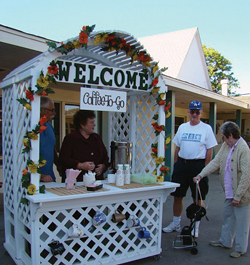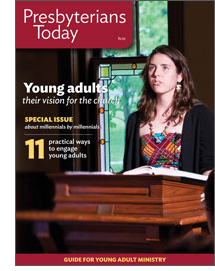The ‘new normal’ in a time of upheaval
Churches redefine themselves to meet society’s changing needs and turn church upside down.
By Paul Seebeck

The Choluteca Bridge in Honduras was built to withstand hurricanes. And indeed when Hurricane Mitch in 1998 devastated much of Honduras, destroying 150 bridges, the Choluteca Bridge remained standing, unharmed. The hurricane, however, had wiped out the roads on each side of the bridge and, worse, had carved a new channel for the Choluteca River. The result was a perfectly designed bridge that led nowhere. It has come to represent a church now disconnected from a changing environment.
It’s a startling image: “the bridge to nowhere.” It sits on dry land—a stand-alone monument to a different time.
Built in the 1930s, the Choluteca Bridge in Honduras was an engineering marvel, constructed with the latest technology available. It spanned the Choluteca River—that is, until Hurricane Mitch devastated Honduras in 1998.
The bridge survived, but the roads disappeared. The river moved, carving itself a new channel. The bridge no longer serves its purpose.
“ ‘The bridge to nowhere’ serves as a metaphor for our churches,” says Ray Jones, coordinator of evangelism for the Presbyterian Church (U.S.A.). “They’re still standing but have been devastated by the storm of cultural and social change going on around them.”
Like those who, after the hurricane, wanted to reroute the river—so that the bridge had a purpose again—many congregations now want to reroute the culture, praying that people will simply show up as they did in the past, Jones says.
“That’s what we mean when we say we are living in ‘the new normal,’ ” he says. “We have to help our churches understand that people aren’t just going to show up again—those days aren’t coming back.”
Visions of the new normal
Covenant Presbyterian Church near Los Angeles International Airport is one of many congregations trying to figure out how to live into the new normal. Started in the late 1940s, when the aerospace industry was beginning, Covenant quickly grew. “They opened their doors and people came,” says the church’s pastor, Cathy Chisholm. “By the 1960s they had over 1,000 people. They were bursting at the seams—had three worship services to make room for everyone.”
But, gradually, Covenant Presbyterian began to lose members. As the airport expanded, the community of Westchester, which Covenant serves, began to lose houses—and people. “We’re down to about 150 in membership now, with about 75 in worship,” says Chisholm. “Many of our folks are in their 80s and 90s.”
Across the country, at First Presbyterian Church in Whiteville, North Carolina, the 115 people who gather for Sunday worship face different challenges.
Like Chisholm in Los Angeles, pastor Joshua Bower felt that the church he serves in rural southeastern North Carolina needed to move in a new direction. “It’s like we needed to turn around,” says Bower. “You have to understand our cultural context. The gospel here has been defined in one way: getting saved.”
Folks grew up in Whiteville primarily learning how to escape from the world, he says. Their central image of the gospel depicted the world on one side, paradise on the other.
New Beginnings, Engage help congregations shift focus
Both Bower and Chisholm found the help they needed in shifting their congregations’ focus—from inward to outward—in resources produced by the Presbyterian Mission Agency, through Evangelism and Church Growth ministries.
Covenant used New Beginnings, a discernment and assessment tool that looks closely at a congregation’s financial and spiritual health, changing neighborhood demographics, potential resources for new ministry, and potential for change.
First Presbyterian used the Engage curriculum, which helps congregations learn how to share their faith, follow Jesus, and serve their communities.

Covenant Presbyterian Church in Los Angeles is exploring ways to engage its community.
Starting small for big results
As Covenant was going through New Beginnings, it decided to start with “something small.”
So, on Christmas Eve of 2012, instead of going into the church courtyard to sing carols and light candles as usual, the congregation decided to go the other way—toward the street, where people could see them.
As church members lined up toward the street, a car drove by. Windows rolling down, it stopped, made a U-turn, and headed to the church parking lot.
“I didn’t know [the car’s occupants] were there until I went back into the sanctuary alone to put things away,” says Chisholm. “That’s when the elder who witnessed it whispered to me, ‘A couple . . . in our church . . . in the back . . . praying.’ ”
The man and woman’s daughter had been in a serious auto accident that day. She was in serious condition, and they had spent the day at a nearby hospital’s emergency room.
“She told me how distraught they were,” says Chisholm, “how they’d been driving around looking for a church to pray in.”
Chisholm ministered to them that night and kept them in her prayers. Later she found out that the daughter had recovered. The mother said she was grateful for the prayers of Presbyterians.
As a result of seeing God work through them in the lives of strangers, Covenant members gained renewed energy.
They’re doing other things now to strengthen their relationship with people in the community. Those efforts range from little things like serving coffee to parents who drop their kids off at school to bigger projects like hosting a resource fair, which helped some 300 people connect with 52 community agencies.
“More and more people outside of the church know we’re here now,” says Chisholm.
Reconsidering what ‘the gospel’ means
In Whiteville, North Carolina, First Presbyterian is also experiencing a new understanding of the gospel. Thanks to Engage, members have begun sharing their faith stories with one another. When elder Rick Hedgecock talked about Jesus being with him when he was most alone, fighting cancer, they openly wept together. (See sidebar.)
“From the moment I introduced it, Engage has been wonderfully freeing for us,” says Bower. “I played that first video [from the Engage online curriculum] of the bridge to nowhere; people were like, ‘Whew!’ They recognized it immediately as a critique [of] what we’d been doing.”
Bower felt energized by people’s reaction, so he began to challenge them with a basic question: What is the gospel? What is the good news?
As they pondered this together and went deeper into Engage, they began to see that they had an incomplete understanding of the gospel. “Yes, we’ve been damaged by evil,” Bower says. “We knew that. But we began to realize that we’ve been designed [for] good—restored to be sent as God’s healing agents in the world.”
Encouraged by one another’s stories and by this new teaching, the church decided to try something new. Following guidelines in Engage, they went on a prayer walk in their neighborhood.
Walking in silence, they soon saw houses they had never seen before. “Our youth [went] around with door hangers, inviting strangers to join us for a barbecue meal and outdoor worship service,” says Bower. “It was a wonderful way for all of us to move—go beyond our four church walls.”
About a dozen new people came—including an elderly neighbor who uses a wheelchair—grateful for the invitation and for the offer of food. Extended family members of congregants also attended.
“What a beautiful day for us,” says the church’s youth leader, Jane Hawthorne. “The weather was great. Spiritually, it was good to see families representing our neighborhood’s socioeconomic and racial diversity walking to church together.”
As part of her final project for her master’s degree from Duke Divinity School, Hawthorne developed an Engage curriculum for youth. “They are on the frontier of ‘the new normal,’ ” she says. “Our youth helped their parents and others engage with the culture around them.”
New church, new approaches
Engaging the surrounding culture is the primary emphasis of Evangelism and Church Growth ministries. The heart of the gospel calls the church, whether a new worshiping community or an existing congregation, to follow Jesus into our communities and neighborhoods, bearing good news.
Next month (Aug. 11–14) Evangelism and Church Growth ministries will host its annual conference in St. Pete Beach, Florida, with the theme “Go/Disciple/Live.”
“Go signifies movement forward, beyond what we know,” says Philip Lotspeich, associate for church growth. “Discipleship is to learn together what it means to be in relationship with Jesus. Live is about thriving where you have been planted.”
Evangelism coordinator Ray Jones adds, “As we see our churches reconnecting their stories to Scripture and their neighborhoods, we see the power of the gospel come alive.”
Paul Seebeck is a mission communication strategist for the Presbyterian Mission Agency.
LEARN MORE
- To watch the Engage video series, download related resources, and order the three-part printed curriculum: pcusa.org/engage
- To consider whether New Beginnings might be the right program for your congregation and to explore other PC(USA) church-growth resources: pcusa.org/churchgrowth

order the special issue Guide to Young adult ministry and read more articles like this one


